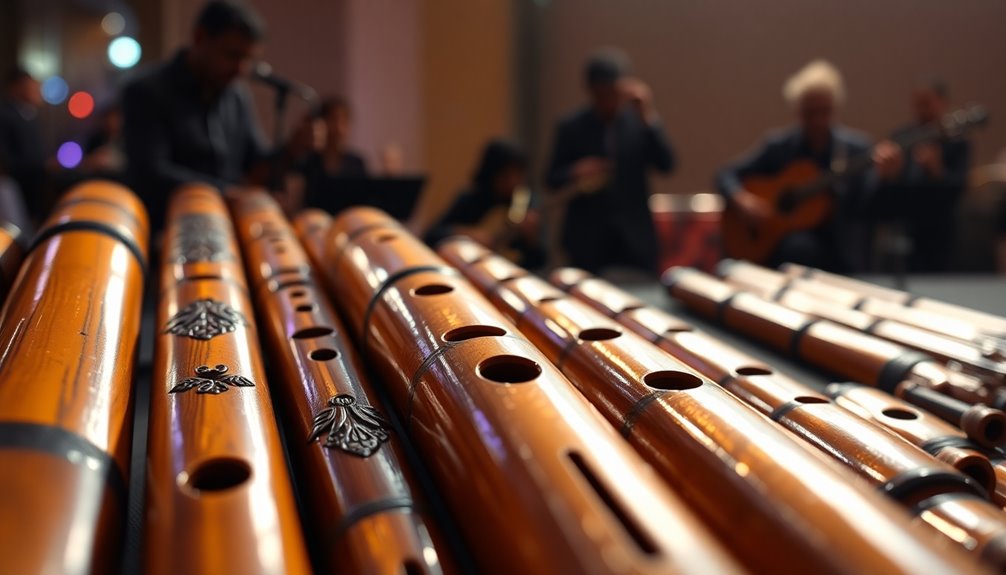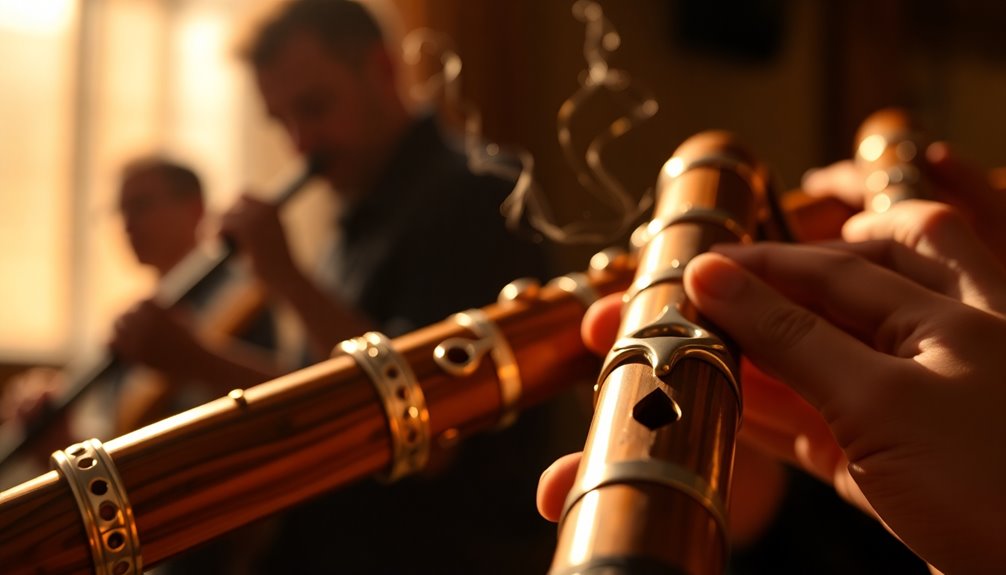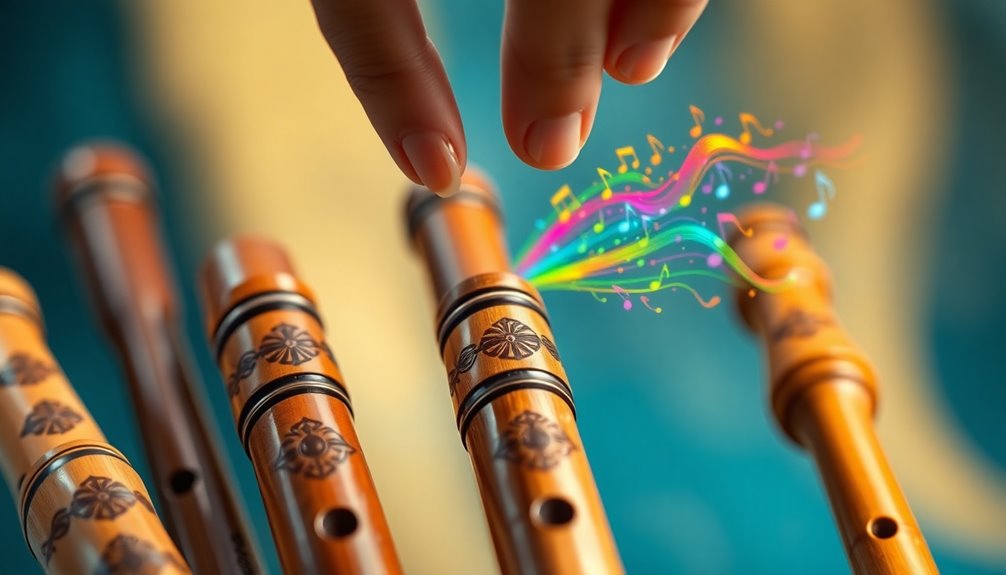Microtonal flutes expand the boundaries of traditional music by integrating pitches smaller than a semitone, showcasing the emotional depth and cultural variety found across global music traditions. By utilizing unique microtonal scales, these flutes break free from the limitations of Western tuning systems, offering new ways to convey complex narratives and feelings. Their enhanced versatility allows for innovative techniques, requiring a shift in breath control and fingerings to achieve subtle pitch variations. Ultimately, as musicians explore the nuances of microtonal flutes, they contribute to a richer musical tapestry that is waiting to be uncovered in further discussions.
Key Takeaways
- Microtonal flutes enable exploration of pitches beyond traditional Western scales, enriching musical expression and cultural narratives.
- The integration of microtonal scales fosters unique emotional resonances, enhancing the storytelling aspect of diverse musical traditions.
- Innovations in fingerings and embouchure techniques expand the capabilities of flutes, allowing for new creative possibilities in performance.
- Educational initiatives are increasingly incorporating microtonal theory, preparing future musicians to engage with this rich musical landscape.
- Collaborative projects between composers and flutists encourage a vibrant exchange of ideas, pushing the boundaries of conventional music.
Understanding Microtonality

In the domain of music, understanding microtonality requires a fundamental shift in how you perceive pitch and scale. You're likely accustomed to the familiar twelve-tone equal temperament, a system that neatly divides the octave into twelve equal parts.
However, microtonal scales challenge this convention by introducing intervals smaller than a semitone, opening up a rich tapestry of musical expression. This exploration invites you to engage with diverse tuning systems that differ considerably from Western norms.
As you explore microtonality, you'll discover various cultural traditions that employ unique microtonal scales, each offering distinct emotional and aesthetic flavors.
For instance, many Middle Eastern and Indian musical systems utilize intervals that fall between the standard Western notes, creating a nuanced sound palette that enhances the musical narrative. Understanding these scales isn't just about recognizing different notes; it's about immersing yourself in the emotional resonance these intervals evoke. Additionally, the use of different tonal qualities in various flute types can further enrich the exploration of microtonal music.
History of Flute Development

Throughout history, the development of the flute has mirrored the evolution of musical practices and cultural expressions across various societies. From ancient instruments crafted from wood, bone, and even metal, flutes have been central to many cultural traditions. The earliest known flutes, dating back over 35,000 years, were made from bird bones and mammoth ivory, showcasing early humans' ingenuity and desire for musical expression.
As you trace flute evolution through various civilizations, you'll notice how each culture adapted the instrument to reflect its unique soundscapes. In ancient Egypt, for example, flutes were often associated with religious ceremonies, while in China, they became integral to folk music and storytelling.
The Western concert flute, developed during the Baroque period, exemplifies a shift towards more complex playing techniques and tonal qualities, emphasizing the flute's versatility. Concert flutes are widely recognized for their bright and clear tone, making them a staple in classical music and jazz.
The Industrial Revolution brought significant advancements in flute design, allowing for enhanced playability and greater range. Key innovations included the addition of keys and changes in material, which expanded the instrument's potential. This progression has led to the modern flute, capable of producing a wide array of sounds and styles.
Understanding the history of flute development not only enriches your appreciation for the instrument but also connects you to a broader narrative of human creativity and cultural exchange. Each flute embodies stories of its past, inviting you to explore the diverse musical traditions that continue to thrive today.
Traditional vs. Microtonal Flutes

When comparing traditional flutes to their microtonal counterparts, you'll find that the differences extend beyond mere construction; they encompass divergent philosophies of sound and musical expression.
Traditional flutes typically adhere to established Western tuning systems, allowing for a familiar and accessible musical experience. They operate within the confines of a twelve-tone equal temperament, which enables musicians to perform a vast repertoire of Western music seamlessly. This standardized approach fosters a sense of belonging among musicians, as it creates a shared framework for collaboration and performance.
In contrast, microtonal flutes invite you into an expansive world of sound characterized by microtonal scales. These flutes break away from the constraints of traditional tuning, offering a palette of pitches that are often not found in Western music. You might encounter intervals smaller than a semitone, allowing for a nuanced exploration of melody and harmony.
This freedom can evoke a range of emotions and cultural expressions, as various musical traditions around the globe utilize microtonality to convey distinct identities and stories. Additionally, microtonal flutes can be seen as an extension of the versatility found in instruments like the alto flute, which enhances both classical and jazz performances.
Ultimately, the choice between traditional and microtonal flutes reflects your artistic intent and the emotional landscape you wish to navigate. By embracing microtonal scales, you can challenge conventional boundaries and explore uncharted sonic territories, enhancing your musical expression and deepening your connection to diverse cultural heritages.
Techniques for Playing Microtonal Flutes

Mastering the art of playing microtonal flutes requires a nuanced understanding of various techniques that differ markedly from those used with traditional flutes. One of the most critical aspects you'll encounter is breath control. Unlike traditional flutes, where pitches are fixed, microtonal flutes allow for a broader range of notes, which means your breath must be more precise.
You'll need to develop a consistent airflow, allowing you to achieve the subtle pitch variations crucial in microtonal music. This involves practicing dynamic control, where you consciously adjust your breath to create microtonal inflections.
Finger positioning also plays an essential role in achieving the desired microtonal effects. Since microtonal flutes often incorporate additional finger holes or alternative fingerings, you'll need to familiarize yourself with these adjustments.
Experimenting with different finger placements can drastically change the pitches you produce. Pay attention to how slight changes in your finger positioning can lead to entirely different tonal textures. This requires both mental and physical flexibility.
Additionally, it's beneficial to engage in regular practice sessions that focus solely on these techniques. Try playing scales that emphasize microtonal intervals, and listen carefully to how your breath control and finger positioning interact.
Incorporating advanced techniques into your practice can further enhance your ability to navigate the complexities of microtonal music.
These exercises won't only enhance your technical skills but also deepen your connection to the music you create. By embracing these unique techniques, you'll find yourself exploring new musical landscapes, enriching your understanding and appreciation of microtonal flutes.
Cultural Significance of Microtonal Music

Microtonal scales can be found in many cultures, from the intricate ragas of Indian classical music to the enchanting maqams of Middle Eastern traditions. These variations not only enrich the soundscape but also underscore the importance of musical diversity. In many communities, the use of microtones is tied to rituals, celebrations, and communal gatherings, emphasizing their role in social cohesion and cultural continuity.
When you listen to microtonal music, you're not just hearing sounds; you're engaging with lived experiences and cultural narratives that have been passed down through generations. This heightened sense of connection fosters a sense of belonging, as it invites you to appreciate the distinctiveness of each culture while recognizing shared human emotions. The incorporation of unique sound characteristics found in various flute types enhances the exploration of microtonal music across genres.
As you explore microtonal music, you'll discover its capacity to bridge gaps between cultures, creating a dialogue that celebrates both individuality and unity. In this way, microtonal music stands as a reflection of the richness of human expression, inviting you to embrace the beautiful complexities of our world.
Microtonal Flutes in Contemporary Music

Microtonal flutes have emerged as a powerful tool in contemporary music, enabling composers and performers to explore new sonic landscapes that challenge traditional tonal frameworks. By utilizing microtonal scales, these instruments allow you to manipulate pitch in ways that were previously unimagined.
This innovation has attracted a diverse group of contemporary composers who are enthusiastic to push the boundaries of musical expression.
Here are three ways microtonal flutes are transforming contemporary music:
- Expanded Melodic Possibilities: With microtonal scales, you can create melodies that resonate with unique cultural contexts or evoke emotional responses that standard tuning can't achieve. This flexibility enriches your musical language.
- Enhanced Textural Depth: The use of microtonal flutes adds layers of complexity to compositions. By incorporating these subtle pitch variations, you can create a richer aural tapestry that captivates listeners and invites deeper engagement.
- Innovative Collaboration: Contemporary composers are increasingly collaborating with flutists who specialize in microtonal techniques. This partnership fosters a creative dialogue that enhances both composition and performance, encouraging experimentation and risk-taking.
As you explore the world of microtonal flutes, you'll find that these instruments not only broaden your musical horizons but also foster a sense of belonging to a vibrant community of like-minded artists. Furthermore, the incorporation of articulation techniques can significantly enhance the expressiveness of microtonal compositions.
Embracing these new sound dimensions can invigorate your work and inspire you to contribute to the evolving narrative of contemporary music.
Influential Microtonal Flute Musicians

An exploration of influential microtonal flute musicians reveals how these artists have considerably shaped the landscape of contemporary music. Their work transcends traditional boundaries, utilizing innovative techniques that challenge conventional flute playing. By integrating diverse cultural elements and contemporary styles, these musicians create a rich tapestry of sound that resonates with audiences seeking deeper connections. The mastery of breath control is essential for these musicians to fully express the nuances of their innovative soundscapes.
| Musician | Influential Styles |
|---|---|
| Robert Dick | Extended techniques, multiphonics |
| Claire Chase | Contemporary classical, improvisation |
| C. Michael Patterson | World music influences, microtonal scales |
| Mario Caroli | Avant-garde, exploration of silence |
| Ewelina Ferenc | Fusion of jazz and classical |
Each of these musicians contributes uniquely to the microtonal scene. Robert Dick, for example, is renowned for his mastery of extended techniques, pushing the limits of what the flute can express. Claire Chase, on the other hand, marries contemporary classical forms with improvisational flair, inviting listeners into a space of spontaneity and creativity. C. Michael Patterson incorporates world music influences, allowing for a global dialogue through sound. Mario Caroli's avant-garde approach, often exploring silence, challenges preconceived notions of music. Finally, Ewelina Ferenc's fusion of jazz and classical styles offers an emotionally charged experience, inviting audiences to explore new domains of musical expression.
These musicians not only broaden the scope of flute music but also create a sense of belonging for those who appreciate the depths of microtonal sound.
Composing With Microtonal Flutes

Composing with microtonal flutes opens up a domain of possibilities for musicians and composers alike. By embracing the unique tuning systems, you can explore new textures and emotional landscapes that traditional Western scales often limit.
Microtonal composition allows you to play with intervals that evoke different cultural contexts or personal reflections, pushing the boundaries of flute creativity.
Here are three key considerations for your microtonal compositions:
- Tuning Systems: Familiarize yourself with various microtonal tuning systems, such as just intonation or the well-tempered scale. Each offers distinct character and can influence your musical choices considerably.
- Extended Techniques: Experiment with extended techniques such as flutter-tonguing, multiphonics, or whistle tones. These methods not only enrich the sound palette but also allow you to explore the flute's capabilities in a microtonal context.
- Cultural Context: Consider integrating elements from non-Western musical traditions, which often utilize microtones. This can add depth and authenticity to your work, making it resonate with broader audiences. Additionally, understanding the flute family can provide insight into how different types of flutes may lend themselves to microtonal exploration.
Challenges and Innovations

Maneuvering the landscape of microtonal flutes presents both significant challenges and exciting innovations for musicians. One primary hurdle you'll face is the tuning challenges inherent in microtonal music. Traditional Western tuning systems often fall short, requiring you to explore alternate scales and intervals that can be intimidating. This push against the norm not only tests your skills but also invites you to innovate.
Innovations in performance techniques have emerged as a response to these challenges. You might discover new fingerings, embouchure adjustments, and extended techniques that redefine how the flute is played, pushing the boundaries of sound and expression. Additionally, the exploration of open-hole flutes allows for greater control over dynamics and timbre, enhancing your ability to express microtonal nuances.
To illustrate these points, consider the following table that highlights the emotional journey musicians face while navigating this unique genre:
| Challenge | Innovation | Emotional Response |
|---|---|---|
| Tuning difficulties | Custom microtonal scales | Frustration, curiosity |
| Limited repertoire | New compositions & collaborations | Excitement, belonging |
| Audience understanding | Educational outreach | Empathy, connection |
| Instrument adaptability | Advanced flute designs | Inspiration, empowerment |
As you engage with these complexities, remember that every challenge is an opportunity for growth. By embracing both the difficulties and innovations, you deepen your connection to the music and to those around you, fostering a rich community of like-minded artists. You're not just playing a flute; you're part of a movement that redefines musical boundaries.
Future of Microtonal Music

The future of microtonal music holds immense potential, with at least three key trends poised to shape its evolution. As you explore the microtonal future, you'll find an exciting landscape brimming with musical exploration that transcends traditional boundaries.
- Technological Advancements: With the advent of digital technology, composers and musicians can now access tools that facilitate microtonal composition and performance. Software and hardware innovations allow for real-time manipulation of pitches, inviting fresh interpretations and creative possibilities.
- Global Fusion: As diverse musical traditions converge, microtonal music serves as a bridge connecting different cultures. The blending of Eastern and Western musical practices encourages artists to explore microtonality, resulting in rich, hybrid sounds that resonate with a wider audience.
- Educational Initiatives: Growing interest in microtonal music is reflected in educational programs that incorporate microtonal theory and performance. As more institutions embrace this approach, you'll witness a new generation of musicians equipped with the skills to innovate and push the boundaries of their art. Additionally, structured resources for learning microtonality can greatly enhance a musician's understanding and application of these concepts.
In this dynamic environment, the microtonal future looks promising. Artists aren't only expanding their own horizons but also inviting listeners to engage in a deeper understanding of music's potential.
Frequently Asked Questions
What Materials Are Used to Make Microtonal Flutes?
When exploring materials for microtonal flutes, you'll find a variety of wood choices and metal alloys that can greatly influence sound quality.
Woods like grenadilla and bamboo offer warmth and resonance, while metal alloys, such as silver or nickel, provide clarity and projection.
Each material contributes unique tonal characteristics, allowing you to tailor your instrument to your personal style.
Understanding these options helps you appreciate the intricate craft behind creating microtonal music.
How Do Microtonal Flutes Differ in Tuning Methods?
So, you've got your standard flute, right?
Now, imagine it's gone rogue with tuning systems that defy the norm. Microtonal flutes embrace alternative scales, allowing you to explore pitches that traditional instruments can only dream of.
Instead of sticking to the usual twelve-tone system, you'll find these flutes using just intonation or even quarter tones, making every note a delightful adventure.
It's a whole new world for you to discover!
Can Anyone Learn to Play a Microtonal Flute?
Absolutely, anyone can learn to play a microtonal flute.
By familiarizing yourself with microtonal scales and practicing unique flute techniques, you'll develop the necessary skills.
Start with basic flute playing to build your foundation, then gradually explore microtonal concepts.
Engaging with communities or seeking guidance from experienced players can enhance your understanding.
What Is the Cost Range for Microtonal Flutes?
When considering the cost range for microtonal flutes, you'll find both affordable options and professional models available.
Typically, affordable flutes start around $200, while professional instruments can exceed $1,000, depending on craftsmanship and materials.
It's important to evaluate what you need based on your skill level and musical goals. Investing wisely guarantees you'll enjoy your experience and feel a sense of belonging within this unique musical community.
Are There Online Resources for Learning Microtonal Flute Techniques?
Yes, there are several excellent online resources for learning microtonal flute techniques. You can find numerous online tutorials that guide you through microtonal exercises, helping you develop your skills.
Websites like YouTube and specialized music forums often feature experienced musicians sharing tips on fingerings and scales.
Additionally, online courses from reputable music schools can provide structured lessons, fostering a sense of community among learners who share your passion for this unique musical approach.
Conclusion
In exploring microtonal flutes, you're not just delving into a niche; you're engaging with a rich tapestry of sound that challenges conventional boundaries. While some may argue that microtonality complicates music, imagine the vibrant landscapes of emotion and culture it reveals. Each note, nuanced and distinct, invites you to experience the profound depth of musical expression. By embracing these instruments, you're participating in an evolving dialogue that honors tradition while boldly charting new creative territories.






